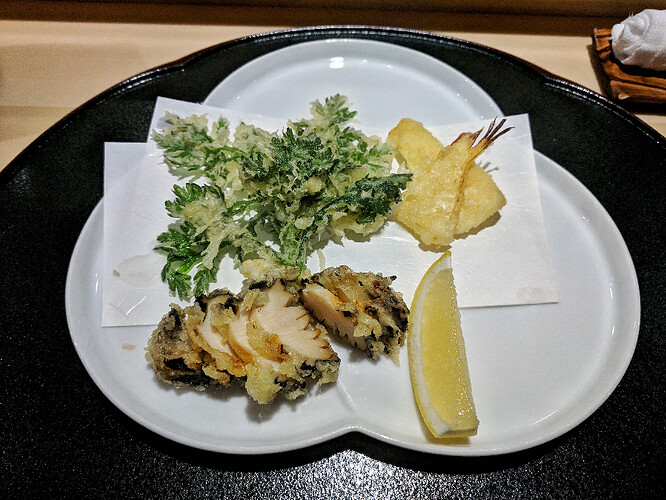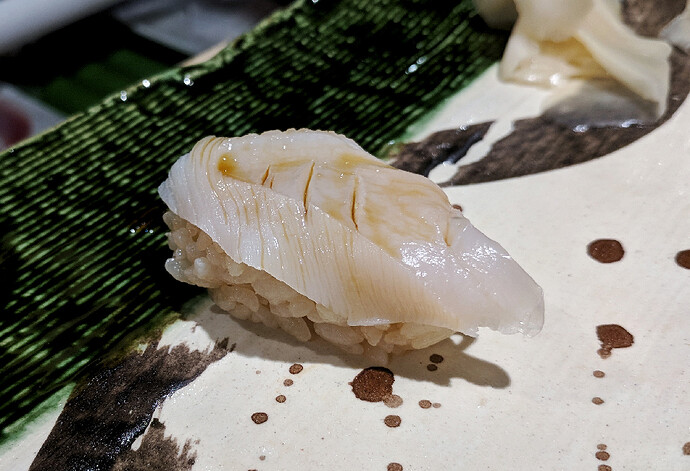Thanks to @helen_s and @Chowseeker1999 for the reservation information. FWIW, we were seated in front of Mori-san at the far end of the main bar (the section that is 8 seats long) right next to the where the dishes get passed to the servers. Throughout the night, Mori-san would work on nigiri for a family of three seated at the second bar section, and he would walk around the corner to serve them.
The chefs and servers were joking all night with each other and with customers, so the atmosphere felt very relaxed and comfortable for our first time dining with Mori-san (and definitely not the last).
Since there are already a bunch of pictures on this thread, I’ll just add ones that haven’t been added before, or are slightly different from what has been posted already:
Ankimo Tofu w/ Santa Barbara Uni, Ossetra Caviar, Baby Onion Sprouts (from Japan), and Ponzu
(cw from top left) Fried Homemade Tofu in Dashi, Steamed/Grilled Broccoli w/ Egg and Miso, Grilled Miso Squid, Firefly Squid w/ Honey Mustard and Pickled Cucumber, Bamboo Shoot Nigri, Hijiki Seaweed Simmered in Soy w/ Yuba-Shiitake-Carrot, Spinach and Shimeji Simmered in Dashi, Kumquat Gelee
Grilled Female Shrimp w/ Charred Kumquat and Water Cress
We were so excited by and in love with this dish that we forgot to ask for clarification on what kind of shrimp this was (it was just described as “sweet shrimp”). The meat was sweet (like hairy crab sweet) and perfectly cooked, but I was surprised at how sweet the roe was, rather than salty. This might have been the dish of the evening for us.
Tempura: Abalone, Bitter Greens (?), Bamboo Shoot
Didn’t catch what type of greens this was, but they were slightly bitter and reminded me a bit of chrysanthemum.
Hot Stone Grill: Wagyu, Portobello, Shimeji, Eringi, Asparagus w/ Wasabi and Soy
We were instructed to cook the wagyu first so the rendered fat would help with the veggies. I think we were too slow, because we ran out of fuel before we got to the portobellos, but I hate mushrooms, so no big loss there (and we wanted to make sure we had enough room for nigiri).
Mirugai (Geoduck)
Baby Onion Sprouts (from Japan) w/ Katsuobushi
I was jokingly thinking that Mori-san was trolling me by just putting random things on the rice just to see if I would eat it or call his bluff, but this was actually really good. The sweet, lightly sharp onion flavor pairing well with the savory notes of the katsuobushi. I would have never thought that something so simple as this would be so enjoyable.
Kanpyo Maki
I had forgotten what kampyo was as I had never been offered it before, so I asked Mori-san if it was dried daikon. But Mori-san corrected my mistake (it’s a dried gourd) and proudly explained that kampyo is one of his favorites (Japanese comfort sushi).
… … … … …
Just a question for you sushi experts, since my sushi knowledge is rather limited and few-and-far-between, the neta was colder than I am used to; I’m assuming that’s intentional, but what’s the rationale behind that choice? It made for an interesting contrast between the warm shari and the cold neta. Also, the wasabi amount was a tiny bit on the heavier side of what we’re used to.
Another interesting tidbit, we asked Mori-san about the soy sauce they use…complex and rich without being overly salty and somehow still being pretty light (as contradictory as that sounds). He takes normal soy sauce and customizes it (not sure how) to compliment his shari recipe. Something, he mentioned, that most sushi chefs do not consider. I don’t usually use soy sauce when eating sushi, but this is one time I might consider making an exception.









